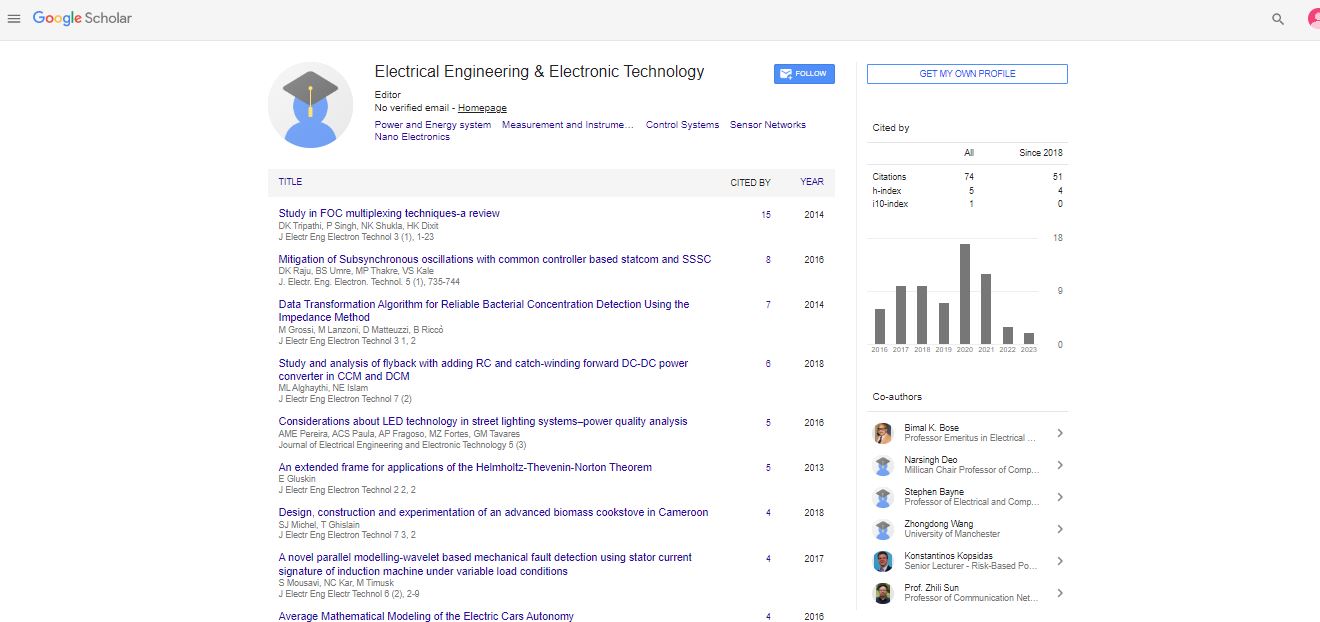Editorial, J Electr Eng Electron Technol Vol: -13 Issue: 1
Sensors and Actuators: Bridging the Physical and Digital Worlds
Suna Timur*
Department of Electrical Engineering, Koç University, Turkey
- *Corresponding Author:
- Suna Timur
Department of Electrical Engineering, Koç University, Turkey
E-mail: suna947@gmail.com
Received: 01-Jan-2025, Manuscript No. jeeet-25-170064; Editor assigned: 4-Jan-2025, Pre-QC No. jeeet-25-170064 (PQ); Reviewed: 18-Jan-2025, QC No. jeeet-25-170064; Revised: 25-Jan-2025, Manuscript No. jeeet-25-170064 (R); Published: 30-Jan-2025, DOI: 10.4172/2325-9838.1000995
Citation: Suna T (2025) Sensors and Actuators: Bridging the Physical and Digital Worlds. J Electr Eng Electron Technol 14: 995
Introduction
Sensors and actuators are fundamental components in modern electronic and mechatronic systems. They serve as the interface between the physical world and digital control systems, allowing machines to interact with their surroundings. A sensor detects changes in physical conditions—such as temperature, pressure, light, or motion—and converts them into electrical signals. An actuator, on the other hand, performs actions by converting electrical signals into physical movement or response [1]. Together, sensors and actuators form the building blocks of automation, robotics, smart devices, and the Internet of Things (IoT).
Discussion
Sensors are used to collect data from the environment. There are various types of sensors, each designed for specific applications:
- Temperature sensors (e.g., thermocouples, thermistors) measure heat levels and are used in HVAC systems, ovens, and industrial processes [2].
- Proximity sensors detect the presence of nearby objects without physical contact. These are commonly used in smartphones, automotive parking systems, and factory automation [3].
- Light sensors (e.g., photodiodes, LDRs) detect illumination levels and are found in cameras, automatic lighting systems, and solar tracking systems.
- Pressure sensors measure the force exerted by a fluid or gas. They’re essential in weather stations, aircraft, and hydraulic systems [4].
- Motion and position sensors, such as accelerometers, gyroscopes, and encoders, are widely used in smartphones, fitness trackers, drones, and robotics.
Sensors play a crucial role in feedback systems, where real-time data is used to monitor and control operations. For example, in a smart thermostat, a temperature sensor detects room conditions, and based on this data, the system adjusts heating or cooling accordingly.
Actuators, in contrast, are responsible for moving or controlling a system or mechanism. Common types include:
- Electric actuators (e.g., motors, solenoids) convert electrical energy into rotary or linear motion.
- Hydraulic actuators use fluid pressure to create mechanical movement and are often used in heavy machinery [5].
- Pneumatic actuators operate using compressed air and are commonly found in factory automation and robotic arms.
- Thermal actuators respond to temperature changes to trigger movement, such as in thermal switches or valves.
Actuators work based on the decisions made by a control system, often relying on input from sensors. For example, in an automated irrigation system, a soil moisture sensor detects dryness, and based on this input, a controller activates a valve (actuator) to water the plants.
The integration of sensors and actuators is key in smart systems like self-driving cars, industrial automation, home automation, and wearable health devices. They enable machines to observe, decide, and act—forming a closed-loop control system that mimics intelligent behavior.
Conclusion
Sensors and actuators are essential components in today's interconnected and automated world. Sensors provide vital information about the environment, while actuators perform the necessary actions based on that information. Together, they enable machines and systems to operate autonomously, efficiently, and intelligently. As technology continues to evolve, the development and application of advanced sensors and actuators will play a critical role in shaping the future of smart technologies, robotics, and Industry 4.0.
REFERENCES
- Grace S, Higgs J (2010). Integrative medicine: enhancing quality in primary health care. J Altern Complement Med. 16: 945â??950.
- Templeman K, Robinson A (2011). Integrative medicine models in contemporary primary health care. Complement Ther Med. 19: 84-92.
- Lake J, Helgason C, Sarris J (2012). Integrative mental health (IMH): paradigm, research, and clinical practice. The Journal of Science and Healing. 8: 50-57.
- Pengpid S, Peltzer K (2018). Utilization of traditional and complementary medicine in Indonesia: results of a national survey in 2014-15. Complement Ther Clin Pract. 33: 156-163.
- Stepleman LM, Penwell-Waines L, Valvano A (2015). Integrated care psychologists and their role in patient transition from medical to psychiatric specialty care settings: a conceptual model. Health Psychol Behav Med. 3: 154-168.
Indexed at, Google scholar, Cross ref
Indexed at, Google scholar, Cross ref
Indexed at, Google scholar, Cross ref
Indexed at, Google scholar, Cross ref
 Spanish
Spanish  Chinese
Chinese  Russian
Russian  German
German  French
French  Japanese
Japanese  Portuguese
Portuguese  Hindi
Hindi 
